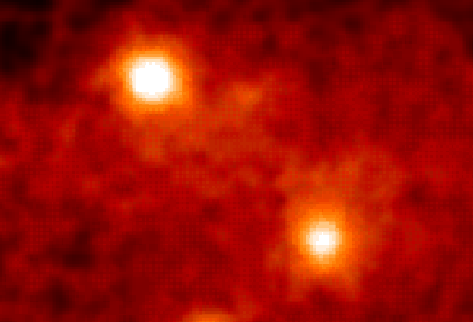Credit & Copyright: NASA, Compton Gamma Ray Observatory
Explanation:
What if you could "see" in gamma-rays? If you could, these two
spinning
neutron stars
or pulsars
would be among the brightest objects in the sky. This computer processed
image shows the Crab Nebula pulsar (below and right of center)
and the Geminga pulsar (above and left of center) in the "light" of
gamma-rays. Gamma-ray photons are more than 10,000 times more
energetic than visible light photons and are blocked from the
Earths's surface by the atmosphere. This image was produced by
the high energy gamma-ray telescope "EGRET" on board NASA's orbiting
Compton Observatory satellite.
For more information see Compton Science Support Center release.
1999 2000 2001 2002 2003 2004 2005 2006 2007 2008 2009 2010 2011 2012 2013 2014 2015 2016 2017 2018 2019 2020 2021 2022 2023 2024 2025 |
Yanvar' Fevral' Mart Aprel' Mai Iyun' Iyul' Avgust Sentyabr' Oktyabr' Noyabr' Dekabr' |
NASA Web Site Statements, Warnings, and Disclaimers
NASA Official: Jay Norris. Specific rights apply.
A service of: LHEA at NASA / GSFC
& Michigan Tech. U.
|
Publikacii s klyuchevymi slovami:
gamma ray - Krabovidnaya tumannost' - pul'sar v Krabe - Pul'sar - gamma-izluchenie
Publikacii so slovami: gamma ray - Krabovidnaya tumannost' - pul'sar v Krabe - Pul'sar - gamma-izluchenie | |
Sm. takzhe:
Vse publikacii na tu zhe temu >> | |
